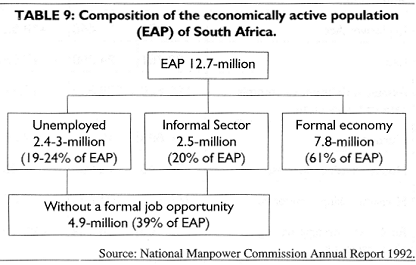This resource is hosted by the Nelson Mandela Foundation, but was compiled and authored by Padraig O’Malley. It is the product of almost two decades of research and includes analyses, chronologies, historical documents, and interviews from the apartheid and post-apartheid eras.
Employment and unemployment
South Africans were classified by economic sector as follows:

Census figures indicate a total of 2 118 648 people or 18% of the economically active population were unemployed. Of this number, 23.3% are black, 16.9% coloured, 12.7% Asian and 4% white. Women comprise 53.4% of the unemployed.
According to the National Manpower Commission (NMC), the real proportion of unemployment (TBVC included) is about 39% of the economically active population (EAP) or 4.9-million people. The NMC says about 300 000 people enter the labour market every year, or 1 200 every working day. Only 15 000 formal job opportunities were created every year between 1981 and 1991, meaning only about 5% of all new entrants to the market are employed in the formal economy every year. Between September 1989 and the second quarter of 1992 at least 250 000 jobs were lost of which 117 000 were in the mining sector, 67 000 in manufacturing and 42 000 in construction.

Unemployment in the homelands is significantly worse than in South Africa as a whole. According to the Development Bank of Southern Africa, the participation of economically active people in the economy was 56.9% for South Africa. This figure for the TBVC as a whole was 33.7% and for the self-governing homelands, 40%.